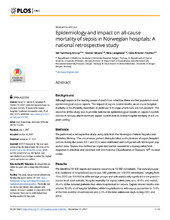| dc.contributor.author | Knoop, Siri Tandberg | en_US |
| dc.contributor.author | Skrede, Steinar | en_US |
| dc.contributor.author | Langeland, Nina | en_US |
| dc.contributor.author | Flaatten, Hans | en_US |
| dc.date.accessioned | 2018-07-05T14:39:16Z | |
| dc.date.available | 2018-07-05T14:39:16Z | |
| dc.date.issued | 2017-11-17 | |
| dc.Published | Knoop ST, Skrede S, Langeland N, Flaatten H. Epidemiology and impact on all-cause mortality of sepsis in Norwegian hospitals: A national retrospective study. PLoS ONE. 2017;12(11):e0187990 | eng |
| dc.identifier.issn | 1932-6203 | |
| dc.identifier.uri | https://hdl.handle.net/1956/17875 | |
| dc.description.abstract | Background: Although sepsis is the leading cause of death from infection, there are few population-level epidemiological sepsis reports. The impact of sepsis-related deaths on all-cause hospital mortality is insufficiently described, in particular in Europe where data are non-existent. The objective of this study was to provide nationwide epidemiological results on sepsis hospitalizations in Norway and to estimate sepsis’ contribution to overall hospital mortality in a European setting. Methods: We performed a retrospective study using data from the Norwegian Patient Registry and Statistics Norway. The occurrence, patient characteristics and outcomes of sepsis hospitalizations during the years 2011 and 2012 were estimated and compared with Norwegian population data. Sepsis was defined as organ dysfunction caused by a dysregulated host response to infection and identified with International Classification of Diseases 10th revision codes. Results: We identified 18 460 sepsis admissions occurring in 13 582 individuals. The annual population incidence of hospitalized sepsis was 140 patients per 100 000 inhabitants; ranging from 10 to 2270 per 100 000 in different age groups and with statistically significant male predominance in all adult cohorts. Hospital mortality for sepsis admissions was 19.4% and overall, 26.4% of the included patients died while hospitalized for sepsis. Sepsis related deaths constituted 12.9% of all hospital fatalities, while hospitalizations with sepsis accounted for 1.0% of the total number of admissions and 3.5% of the total admission days during 2011 and 2012. Conclusions: This study confirms that hospitalized sepsis is frequent in Norway and a major contributor to hospital fatalities in a European setting. The incidence is higher among men than women. Sepsis is in particular a disease of the elderly, and its impact on health-care will assumingly continue to increase in parallel with an aging population. Improvements in treatment and survival of sepsis could influence population mortality, and sepsis should receive greater attention in official death statistics in the future. | en_US |
| dc.language.iso | eng | eng |
| dc.publisher | Public Library of Science | eng |
| dc.relation.ispartof | <a href="http://hdl.handle.net/1956/17877" target="blank"> The epidemiology and characteristics of sepsis in Norwegian hospitals</a> | |
| dc.rights | Attribution CC BY | eng |
| dc.rights.uri | http://creativecommons.org/licenses/by/4.0/ | eng |
| dc.title | Epidemiology and impact on all-cause mortality of sepsis in Norwegian hospitals: A national retrospective study | en_US |
| dc.type | Peer reviewed | |
| dc.type | Journal article | |
| dc.date.updated | 2018-03-07T14:19:24Z | |
| dc.description.version | publishedVersion | en_US |
| dc.rights.holder | Copyright 2017 Knoop et al. | |
| dc.identifier.doi | https://doi.org/10.1371/journal.pone.0187990 | |
| dc.identifier.cristin | 1529616 | |
| dc.source.journal | PLoS ONE | |

